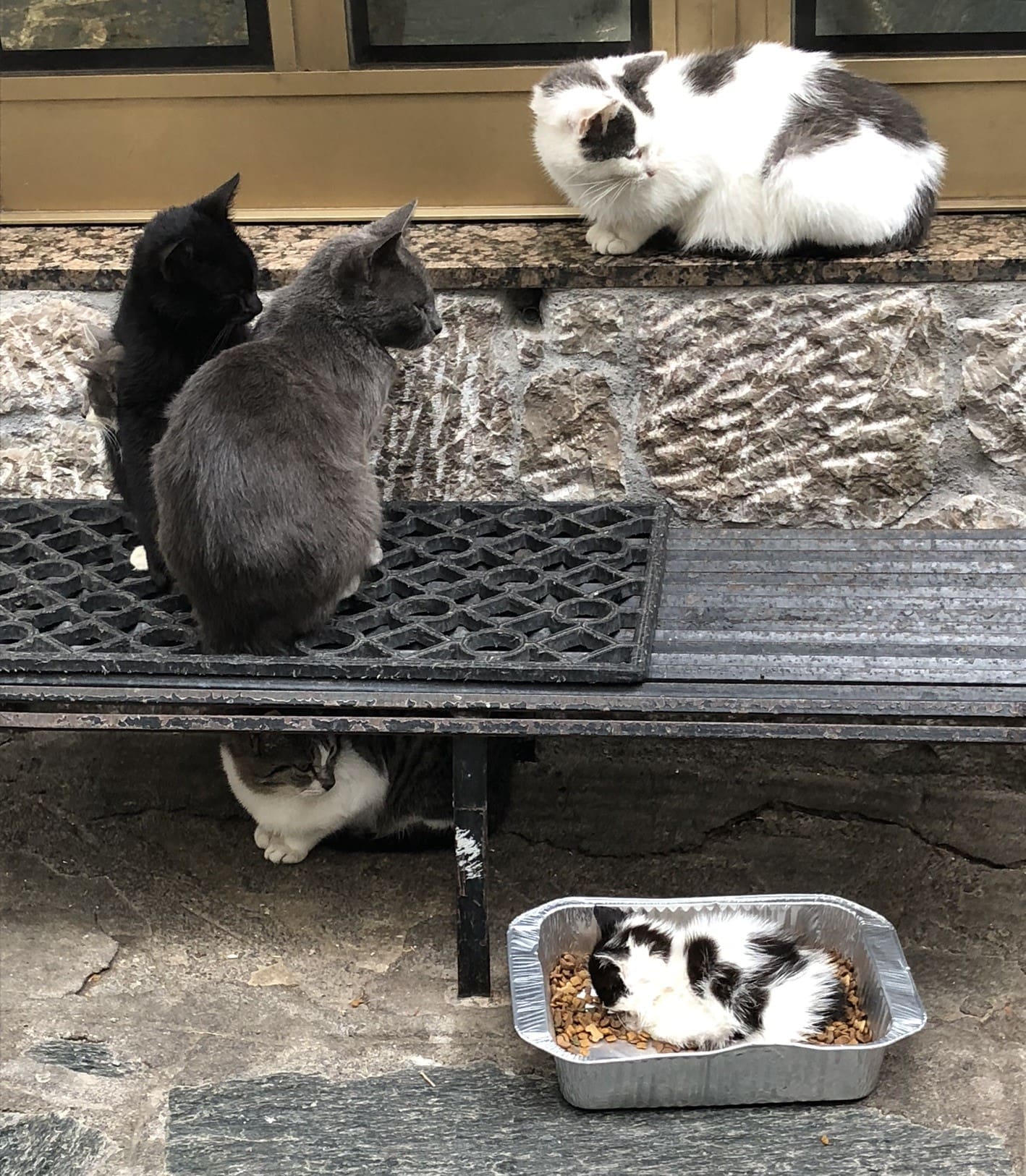“The Rule of Benedict spends only three paragraphs on obedience – thought by many moderns to be the arch-virtue of the spiritual life. But Benedict has nineteen paragraphs on humility. No doubt about it: he was trying to get our attention.” [1]
Hi! I’m Resident Novice William. So glad you’re here!
May I first tell you why I am “the lucky one” to write about humility?
The Beginning of the Story
At a recent instruction for Resident and Worldwide Novices Br. Ricky, OSB-F, our novice master, waxed eloquent on humility as described in Chapter 7 of the Rule of St. Benedict. He illustrated Benedict’s ladder of humility with an actual mini ladder that he had made.
Each rung of the ladder was labeled with one of the 12 steps of humility. Very clever, since we felines love to zip up and down ladders. Encouraged by the Worldwide Novices who had joined on Zoom, we took turns tapping our paws on the various rungs. Feline giggles abounded.
Novice William Reacts to the Twelve Steps of Humility
My laughter didn’t last long. Other than the first two steps – that we keep the fear (i.e., reverence) of God before our eyes and strive to do God’s will as did Jesus, the rest of the steps made my fur stand on end. Most were decidedly un-feline.
Resident Novice William spends
many hours grooming
What feline, or what human for that matter, would ever be content with “the lowest and most menial treatment or task?” (Step 6)
What feline or human “is convinced in their heart that they are inferior to all and of less value?’’ (Step 7)
What feline or human wants to lay their soul bare and confess wrong actions or thoughts? (Step 5).
Hisssss!!
The bluntly stated verses from the Rule and the explanation of each step by our enthusiastic novice master were more than I could handle. I just could not suppress a hiss as each step was described.
Novice William’s New Project
I’ve developed a reputation in the Cloister for being a tad self-focused. My perpetual grooming plus the hisses I couldn’t suppress that day got me into trouble. Br. Ricky gave me a special project – a study of humility in Chapter 7 of Benedict’s Rule! He mewed gently that he hoped the exploration and God’s grace would help me learn about myself and have a few raggy edges smoothed out.
What could I do? I ‘m a novice and I “cherish Christ above all” (RB 5.1). I obeyed my novice master.
So, in between grooming sessions I studied and hissed, pondered and wrote. I now offer you this instruction. I hope you’re inspired by what inspired me! Yes, reader, I did have a small conversion in favor of humility.
Although a Benedictine feline, Br. Boniface, OSB-F,
has a jaded view of humility.
“I’ll never give it a paw,” he hisses.
“Even though I won’t mew this to anyone, I really AM Top Cat!”
STOP! Time for Reflection
Before we jump into chapter 7, here’s a paws to reflect.
One of my favorite feline monastic scholars, Sr. Maria Benedicta Ramos, OSB-F, PhD-F, mewed that “humility” is an unpopular and loaded word. Meeeeow! Is that true! Sr. Maria made a great suggestion that helped me clarify my preconceived notions and biases.
Write down all the spontaneous associations the word “humility” evokes in you. [2]
What are your associations with this word? What does “humility” bring to your mind?
For me: weakness, being stepped all over, wishy-washy, no fun, too impossible, too hard. Add to these, I really don’t know what humility is except that it’s un-feline.
The Burdens We Carry
In her book The Rule of Benedict: Christian Monastic Wisdom for Daily Living, Amma wrote of the burden that can be lifted through humility.
“Humility is not a sought-after personal quality and is generally misunderstood. We often think humility means humiliation and weakness. But Jesus called himself humble in heart and promised rest for those carrying heavy burdens (Matthew 11:28–20). The heavy burden we carry is ourselves—our drive to get what we want, our belief that we are always right, our self-focus.” [3]
Novice Scholar Little Jenny is having fun reading about humility in the Rule of the Master. “Wow!” she meows. “The Master gives a beautiful description of heaven, the goal of humility in his Rule. (Chapter 10, verses 92-120) Benedict is more down-to-earth, though. His goal is love.”
For History Buffs – Where Did Benedict’s Twelve Steps of Humility Come From?
Note: If you aren’t a history buff you may skip this section.
To help me out our Novice Scholar Little Jenny did some research on the origins of Chapter 7. Here’s what she found out.
In his Institutes, chronicler of Egyptian monasticism John Cassian (360-435 CE), listed 10 “signs” by which humility is recognized. As the direct source for Benedict’s 12 steps, Cassian’s 10 signs line up alongside the Benedict’s 12 steps. [4]
Another of Benedict’s sources, the Rule of the Master (RM), expanded Cassian’s signs with two numbered additions– Step 1 (fear of God) and Step 12 (the total presence of humility in all that is done.) The Master also created the image of the ladder. [5]
RM focuses on humility as the path leads to the joys of heaven. Benedict’s path is towards greater love of God and others. Benedictine humility is grounded in and supports relationship and community. Sr. Scholastic Muffin, another wonderful feline Benedictine scholar, mews, “Humility is to lead to positive human [and feline] relationships.” [6]
Worldwide Novice Angelo of Castelmola, Sicily, is a part of a very motley group of gatti randagi, i.e., stray cats, shown here.
Benedict’s Community and His Motivation
Benedict wanted to create a community where all were respected. Everyone was to support one another. Who or what individuals were before their monastic life was not to matter. Peace was to be the quest and aim (Ps 34: 14-15 in Prologue 17b). This meant peace within the community, peace in one’s heart, and peace with God.
But the world in which Benedict and his monastics lived was highly stratified. All kinds of men came to the monastery – the powerful and the aristocracy, the slave and the very poor. Sort of like the motley mix of many feline households. Creating cohesive community with this lot must have been a huge challenge for Benedict.
Another challenge was the overtone to “humility” in Benedict’s day. The Latin word humilitas, from which humility is derived, was used to designate the lowest class of population. These were the folks at the bottom. [7] Would an aristocrat want humility??
Humility and Self-Knowledge
An important step to building community, respect, and peace was to help the monastics learn about themselves – strengths, weaknesses, hot buttons, etc. Benedict wanted his motley crew of monastics to let go of attitudes and actions that stood in the way of their relationship with God and with others.
Human Benedictine Anselm Grün shares that Benedict’s chapter on humility “is a description of a growing experience of God and of an ever more lucid self-knowledge.” Through the steps of humility, we “ come closer to God and are more and more transformed by God’s loving and healing closeness.” [8] Humility is not a virtue to be earned but an experience (or process) into which we grow. It culminates in the 12th step, perfect love of God.
Feline Oblate Cynthia Marie mews in happiness as she reaches Step 12 on the ladder of humility – the perfect love of God
Humility and Acceptance
Humility comes when we discover and then accept our weaknesses.
When you and I don’t accept ourselves, our lives and who we are, we sure aren’t peaceful. More likely we are scurrying around trying to change others and the circumstances of our lives. Most exhausting. Whether we realize and name it or not, pride, not humility, drives the bus.
Humility helps us gently set aside who we think we are or want to be. For example – perfect, the best or the absolute worst, above everyone else, setter of the pace, the center of attention, the top cat, etc., etc., etc. We turn from all of this towards who we are truly meant to be in God’s wisdom. Humility means total acceptance of our own life just as we are. [9]“
Humility—its root meaning ‘earth’—grounds us in the truth of who we are. It helps us accept ourselves and others and allow life to unfold around us without the struggle to continually change things.
“Humility enables us to bend to God’s way instead of being entrenched in our own way. We become better able to see God’s direction for us through scripture and other resources, the circumstances of our life, and the guidance of others (obedience).” [10]
Through humility “…we can recognize and embrace our brokenness and dependence on God for mercy. Humility is accepting everything in its right perspective; its mantra is, ‘By the grace of God, I am what I am.’” [11]
Little Bridgett on the ladder of humility. She is a bit apprehensive. But she knows that know that God will help her learn about herself and grow to be a loving feline.
The Twelve Steps in the Ladder of Humility
Br. Ricky mews that we can do nothing without the grace of God. Our role is not to nap but to get our paws moving in the right direction. Benedict gives us with12 ways to do just that. They are transformative as we loosen the grip of our ego drives. The steps of humility are a path to self-understanding, compassion and love. They help us to grow in our ability to be present to others. This builds community.
Humility →
The Gift of Listening →
Creates Community
Below I now share Amma Jane’s interpretation of the 12 steps, expressed more gently that what we read in the Rule.
As you read each one, think about how each step encourages strong community and relationships. Consider how each would help you become a more peace-filled, compassionate person.
Step 1 – To accept that God is present in my life and to live from that awareness
Step 2 – To make doing God’s will my prime directive.
Step 3 – To recognize that I cannot always be in control, and to listen and respond to those who are – to be obedient.
Step 4 – To be patient and steadfast when our obedience places us in a difficult or unfair situation.
Step 5 – To practice self-disclosure with someone I trust.
Step 6 – To be willing to do the most menial tasks and be at peace with them.
Step 7 – To recognize that I may not have the final answer and so to listen to other people.
Step 8 – To take no action except those endorsed by people who show wisdom and understanding.
Step 9 – To listen more than to talk.
Step 10 – To not laugh excessively.
Step 11 – To speak quietly and briefly with humility and restraint.
Step 12 – To know myself and my limitations, yet know I’m forever in God’s presence and held in God’s constant love; therefore I can live calmly and peacefully. [12]
Following the Ladder of Humility
It’s no accident that the first step of humility is to keep the fear of or the reverence of God before us at all times. That’s the beginning of the path.
The steps are not necessarily taken in numerical order. I have learned to ask the Holy Spirit to illumine where I need to grow the most. Then I pounce on the step I need to practice and ask God to help and guide me.
Here’s a question for you to begin using the steps of humility.
What step on the list above causes your paws to dig in the most?
That step is where to begin. Intentionally begin to practice this step. God will help.
A tad confused, Novice Beauregard Furmuch ends up going the wrong way on
the ladder of humility.
A Closing Mew for Humility
C. S. Lewis offered this definition of humility that sums it all up.
“True humility s not thinking less of yourself; it is thinking of yourself less.” [13]
Meee-ow! I really like that! I will do my best to work toward that goal.
Join Novice William on the Ladder of Humility
Whew! That was a lot. Has Benedict gotten your attention? Sure hope so.
I’m going to do my best to groom a bit less every day. I’ll use that extra time to be a helpful and caring novice to all in the cloister. Maybe pray, too.
Be sure to check out my article in “Felines Unpack the Rule of St. Benedict.” I unpacked two knotty steps – 6 and 7.
Tap here to reach Novice Willim’s unpacking of Steps 6 and 7.
Thank you for reading all of my instruction. Well done, good and faithful friend. Have a blessed day.
Your Resident Novice confrere,
Novice William
ENDNOTES
[1] Joan D. Chittister, Twelve Steps to Inner Freedom: Humility Revisited (Erie, PA: Benetvision, 2003), 53.
[2] From the eminent Benedictine scholar, Sr. Aquinata Böckmann, OSB, PhD, From the Tools of Good Works to the Heart of Humility: A Commentary on Chapters 4 – 7 of Benedict’s Rule (Collegeville, MN: The Liturgical Press, 2017. Originally published in German in 2011), 124.
The amazing scholar Aquinata Böckmann, OSB, PhD
[3] Jane Tomaine, The Rule of Benedict: Christian Monastic Wisdom for Daily Living (Nashville, TN: Skylight Paths Publishing, 2017), 153.
[4] John Cassian, The Institutes, trans. Boniface Ramsey (Mahwah, NJ: Newman Press of the Paulist Press, 2000), Book 4: Chapter 39, p. 99-100.
NOTE: Cassian’s Conferences and Institutes are listed in the Rule as one of the recommended guides to “the true way to reach the Creator.” RB 73.5-6
[5] The Rule of the Master, trans Luke Eberle (Kalamazoo, MI: Cistercian Publications, 1977), Chapter 10, p. 131-139.
[6] Böckmann, 134.
[6] Ibid., 131.
[8] Anselm Grün in Böckmann, 128.
Anselm Grün is a German Benedictine monk who has written many articles and books on the Rule of St. Benedict.
[9] Böckmann, 128.
[10] Tomaine, The Rule of Benedict: Christian Monastic Wisdom for Daily Living, 153.
[11] Judith Sutera, OSB, St. Benedict’s Rule and Daily Commentary (Collegeville, MN, The Liturgical Press, 2021), 94.
Sr. Judith is a Benedictine in the community of the Benedictine Sisters of Mount St. Scholastica in Atchison, Kansas.
[12] Jane Tomaine, St. Benedict’s Toolbox: The Nuts and Bolts of Everyday Benedictine Living (Harrisburg. PA: Morehouse Publishing, 2015), 214-218.
[13] Sutera, 94.
P.S. Br. Ricky said that since I put in a photo of Sr. Aquinata Böckmann and Sr. Judith Sutera, I should do the same for Fr. Anselm Grün. Here he is!
Another amazing Benedictine scholar, Fr. Anselm Grün, OSB




















